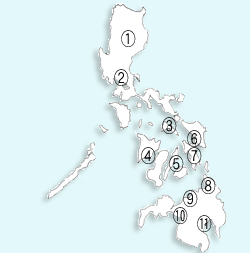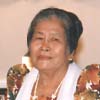 |
Women made to be Comfort Women - Philippines |
|
  |
In December 1941, Japanese military forces landed on the island of Luzon in the Philippines, a US territory. Manila quickly surrendered, and a military government was installed on 3 January 1942. Filipinos mounted a vigorous guerrilla offensive and organized a resistance movement to oppose Japanese military rule. The Japanese forces waged a cruel campaign in an attempt to suppress the guerrilla opposition. Of the 381 cases of Class B and Class C war crimes brought before post-war military tribunals in the Philippines, almost half involved massacres of local civilians (138 cases) or rapes (45 cases).
|
 |
|
In Manila(in the map 2), according to a research report of one section of SCAP, there were 12 houses of relaxation (comfort stations) and 5 brothels for privates and non-commissioned officers. War prisoners testified that there were 5 or 6 comfort stations where Korean, Filipino and Chinese women worked. On the island of North Luzon comfort stations existed at Bayonbong(1). In the Central Visaya region on the island of Masbate(3) there was a comfort station named "Military Club". At Iloilo(4) on the island of Panay two comfort stations existed. It can be ascertained that in 1942 in the first one 12 - 16 women worked and in the second one 10 - 11 women. At Cebu(5) on the island of Cebu a Japanese proprietor opened a comfort station. At Tacloban(6) on the island of Leyte in a comfort station managed by Filipinos 9 Filipino women worked.
In Burauen(7) of the same island a comfort station was opened by August 1944.
In Butuan(8) on the island of Mindanao a comfort station was opened with three Filipino women in 1942. And it is known that in Cagayan(9) of the same island the third comfort station was established in February 1943. That means that there were three comfort stations in Cagayan. In Dansaran(10) in the central part of the island there was a
Comfort station. In Davao(11) of the island there was a comfort station where Koreans, Taiwanese and Filipinos were brought and forced into service.
Also in parts of the Philippines occupied by the Japanese military, according to victims' testimonies, a number of women were raped and abducted through violent means to garrison buildings, then confined there and forced to provide sexual services. Such victims can be thought of as equivalent to comfort women. In many of these cases, their fathers or husbands were killed in front of the women and their other family members.
|
|
From the Final Report of Philippine government (Full text here ) )
Many of the Lolas were taken forcibly by Japanese soldiers while in their home. A few were taken while they were at home while a few were either working; or running an errand for their parents. Many of them were still single but there were other married women. A Lola from Bicol was asleep when the Japanese came to their village and rounded up all men and young women and were taken in the elementary school building; where they were held until the next morning;. Then, they were taken to the municipal hall. Another Lola was told by her mother to buy food from the nearby town while the other one was gathering "sisid" (wet) rice near the pier in Malabon.
They were taken to Japanese military camps or garrisons which were former wither municipal/provincial building, big private houses, elementary/high school buildings, hospitals or churches. A Lola narrated that all the corners of a particular church in Manila had a woman being raped by the Japanese every night. There was even a case where the Lola's house itself was converted into a garrison. A tunnel was reportedly used to house comfort women.
Their period of confinement ranged from three days to more than a year. About 25 percent of them were confined for four months or longer while 17 percent were kept for three months and l6 percent were there for one month. All the Lolas reported to have been raped throughout their period of confinement. Seven Japanese soldiers first raped this Lola who hails from the Visayas in their house while the other family members were being interrogated. And every night thereafter for seven days, three to five Japanese soldiers raped her. A Lola from Manila was raped a month after her capture. Of her six to seven month confinement in the garrison, three or more soldiers continuously raped her about three times a week.
|
|
|
|
|
 The case of Maria Rosa Henson The case of Maria Rosa Henson
Maria Rosa L. Henson was born in Pasay City on 5 December 1927. She was an extramarital daughter of a bid landowner and his housemaid. She was raped by Japanese soldiers first in February 1942. While she went to fetch firewood with her uncles and neighbors for her family, she was caught and raped by three Japanese, one of whom seemed to be an officer.. After two weeks she was again raped by the same Japanese officer, while fetching firewood. She felt strong anger toward the Japanese military, and joined the HUKBALAHAP, an anti-Japanese guerilla group. A year passed. In April 1943 she was arrested by Japanese at a check point in the suburbs of Anheles and taken to the headquarters. There she was forced to be a comfort woman.
She said that during the occupation, after being raped the first time, she joined the guerrilla resistance movement, then was captured, raped again, taken by order of Japanese military headquarters and confined with other women for nine months, during which time she was raped time after time.
Rosa Henson was taken into a hospital which was converted into a garrison. Together with other six women, she was forced to provide sex for their Japanese captor. After three months, she was transferred to another comfort station which was a former rice mill. Lola and a group of other young women were washing clothes when a Filipino collaborator of the Japanese suggested that they could earn money from washing clothes for the Japanese soldiers. They went with the collaborator to three Japanese soldiers who were waiting for them. They were taken to a two-storey houses and were held there for a year washing clothes during day time and being raped at night( Testimonies of Rosa Henson ). ). |
|
|
|
|
  |
|
|













